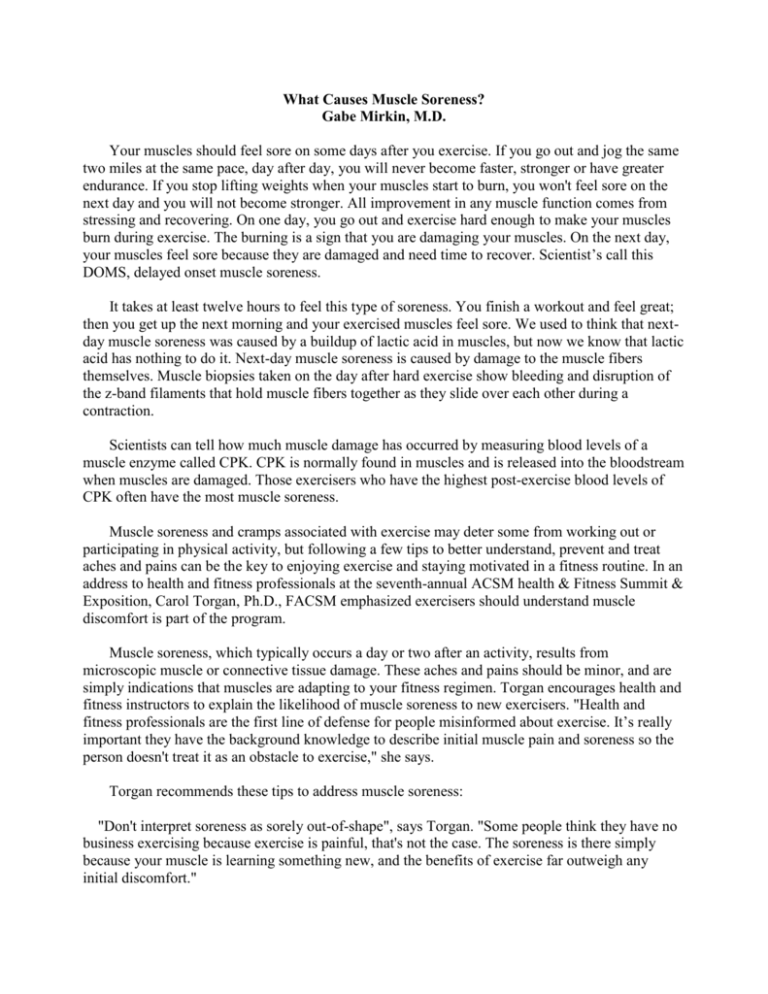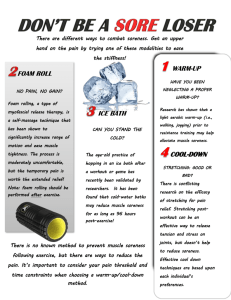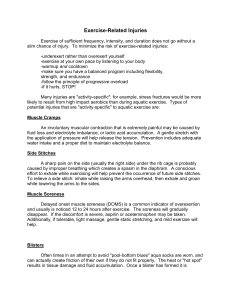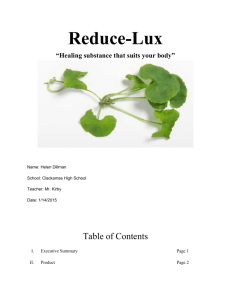What Causes Muscle Soreness
advertisement

What Causes Muscle Soreness? Gabe Mirkin, M.D. Your muscles should feel sore on some days after you exercise. If you go out and jog the same two miles at the same pace, day after day, you will never become faster, stronger or have greater endurance. If you stop lifting weights when your muscles start to burn, you won't feel sore on the next day and you will not become stronger. All improvement in any muscle function comes from stressing and recovering. On one day, you go out and exercise hard enough to make your muscles burn during exercise. The burning is a sign that you are damaging your muscles. On the next day, your muscles feel sore because they are damaged and need time to recover. Scientist’s call this DOMS, delayed onset muscle soreness. It takes at least twelve hours to feel this type of soreness. You finish a workout and feel great; then you get up the next morning and your exercised muscles feel sore. We used to think that nextday muscle soreness was caused by a buildup of lactic acid in muscles, but now we know that lactic acid has nothing to do it. Next-day muscle soreness is caused by damage to the muscle fibers themselves. Muscle biopsies taken on the day after hard exercise show bleeding and disruption of the z-band filaments that hold muscle fibers together as they slide over each other during a contraction. Scientists can tell how much muscle damage has occurred by measuring blood levels of a muscle enzyme called CPK. CPK is normally found in muscles and is released into the bloodstream when muscles are damaged. Those exercisers who have the highest post-exercise blood levels of CPK often have the most muscle soreness. Muscle soreness and cramps associated with exercise may deter some from working out or participating in physical activity, but following a few tips to better understand, prevent and treat aches and pains can be the key to enjoying exercise and staying motivated in a fitness routine. In an address to health and fitness professionals at the seventh-annual ACSM health & Fitness Summit & Exposition, Carol Torgan, Ph.D., FACSM emphasized exercisers should understand muscle discomfort is part of the program. Muscle soreness, which typically occurs a day or two after an activity, results from microscopic muscle or connective tissue damage. These aches and pains should be minor, and are simply indications that muscles are adapting to your fitness regimen. Torgan encourages health and fitness instructors to explain the likelihood of muscle soreness to new exercisers. "Health and fitness professionals are the first line of defense for people misinformed about exercise. It’s really important they have the background knowledge to describe initial muscle pain and soreness so the person doesn't treat it as an obstacle to exercise," she says. Torgan recommends these tips to address muscle soreness: "Don't interpret soreness as sorely out-of-shape", says Torgan. "Some people think they have no business exercising because exercise is painful, that's not the case. The soreness is there simply because your muscle is learning something new, and the benefits of exercise far outweigh any initial discomfort." No one is immune to muscle soreness. Exercise neophytes and body builders alike experience delayed onset muscle soreness. "Anyone can get cramps or DOMS, from weekend warriors to elite athletes,” says Torgan. "The muscle discomfort is simply a symptom of using your muscles and placing stresses on them that are leading to adaptations to make them stronger and better able to perform the task the next time." Delayed-Onset Muscle Soreness Even though the benefits of regular exercise are well known, many of us don't do it. One reason may be that pain or discomfort sometimes goes along with fitness activities. But starting or continuing an exercise program may be easier if you understand what muscle soreness is and what to do about it. Sorting Out Soreness Aside from pain of muscle injuries such as strains, there are two common kinds of exercise related muscle soreness. One is acute soreness, which occurs during or immediately after exercise; the other kind is delayed-onset muscle soreness (DOMS), which develops 12 hours or longer after exercise. Acute soreness Muscle soreness during and immediately after exercise usually reflects simple fatigue, caused by a buildup of chemical waste products of exercise. If so, the discomfort will often subside after a minute or two of rest. Once the soreness goes away, you can usually continue exercising without any residual effects. If discomfort persists despite a rest period, you should stop your activity and rest the part of the body that is involved. You should not proceed with your workout until you're able to exercise that area without pain. Delayed soreness DOMS after a workout is common, particularly if you aren't used to the activity. If, for example, you haven't exercised for 6 months, and then you suddenly walk three miles and do some push-ups, you may feel soreness over much of your body the next morning. You may also notice muscle stiffness and weakness. Such symptoms are a normal response to unusual exertion and are part of an adaptation process that leads to greater strength once the muscles recover. The soreness is generally at its worst within the first two days following the activity and subsides over the next few days. Causes of DOMS DOMS is thought to be a result of microscopic tearing of the muscle fibers. The amount of tearing depends on how hard and how long you exercise and what type of exercise you do. For example, activities in which muscles forcefully contract while they are lengthening tend to cause the most soreness. These "eccentric" contractions, as they are called, provide a braking action; they occur in activities such as descending stairs, running downhill, lowering weights, and performing the downward movements of squats and push-ups. In addition to microscopic tearing, swelling may take place in and around a muscle, which can also contribute to delayed soreness. Such swelling increases pressure * Gentle stretching may help restore flexibility. * Massage may also offer some pain relief. * Application of balms, creams and/or ice, as well as submersion in warm water/ may provide temporary relief. * "Don't avoid activity because of muscle soreness," says Torgan. "In fact, keeping the muscle in motion can be beneficial." Starting a workout program can be challenging. Making the time to exercise, creating a balanced routine, and setting goals are hard enough, but add to that the muscle soreness that comes with adapting to that regimen, and it may be difficult to stay on track. Chances are, you won't be leaping out of bed to get to the gym when it hurts to hold your arm up to brush your teeth. After participating in some kind of strenuous physical activity, particularly something new to your body, it is common to experience muscle soreness, say experts. "Muscles go through quite a bit of physical stress when we exercise," says Rick Sharp, professor of exercise physiology at Iowa State university in Ames. "Mild soreness is just a natural outcome of any kind of physical activity," he says. "And they're most prevalent in beginning stages of a program." Exercise physiologists refer to the gradually increasing discomfort that occurs between 12 and 24 hours after activity as delayed onset muscle soreness (DOMS), and it is perfectly normal. "Delayed onset muscle soreness (DOMS) is a common result of physical activity that stresses the muscle tissue beyond what it is accustomed to," says David 0. Draper, professor and director of the graduate program in sports medicine/athletic training at Brigham Young University in Provo, Utah. To be more specific, says Draper, who's also a member of the heat-response pain council, delayed onset muscle soreness occurs when the muscle is performing an eccentric or a lengthening contraction. Examples of this would be running downhill or the lengthening portion of a bicep curl. "Small microscopic tears occur in the muscle," he says. The mild muscle strain injury creates microscopic damage to the muscle fibers. Scientists believe this damage, coupled with the inflammation that accompanies these tears, causes the pain. "The aches and pain should be minor," says Carol Torgan, an exercise physiologist and fellow of the American College of Sports Medicine, "and are simply indications that muscles are adapting to your fitness regimen, on the neighboring structures, resulting in greater muscle pain and stiffness. Eccentric muscle contractions tend to cause both micro tearing and swelling. Preventing DOMS Certain tactics may enable you to avoid delayed soreness altogether, or at least keep it to a minimum. One step is to warm up thoroughly before activity and cool down completely afterward, this can be done by stretching the muscles that you will be using and by doing a few minutes of light/ low-impact aerobic activity, such as walking or hiking. Dealing with soreness Let's say you overdo it one weekend by hiking and playing flag football or pickup basketball. What are your options? Most experts would say the soreness will go away in 3 to 7 days with no special treatment, but there are some things you can do that may reduce the soreness and speed your recovery to some extent. Measures include applying ice, gently stretching/ and massaging the affected muscles/ which may be helpful for some people and poses little risk if done sensibly. Also, non steroidal anti-inflammatory medications like aspirin or ibuprofen may reduce the soreness temporarily, though they won't actually speed healing, these medications are available over the counter, and they can be prescribed by physicians in greater strengths. And there is some evidence that vitamin C may decrease soreness.







